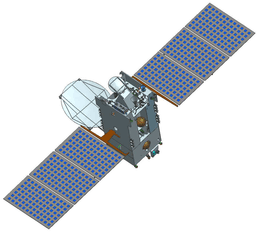GSAT-31
GSAT-31 is a high-throughput telecommunication satellite developed by the Indian Space Research Organisation (ISRO).[2]
 GSAT-31 in deployed configuration | |
| Mission type | Communication |
|---|---|
| Operator | ISRO |
| COSPAR ID | 2019-007B |
| SATCAT no. | 44035 |
| Mission duration | Planned: 15 years Elapsed: 1 year, 6 months, 3 days |
| Spacecraft properties | |
| Bus | I-2K |
| Manufacturer | ISRO Satellite Centre Space Applications Centre |
| Launch mass | 2,536 kg (5,591 lb) |
| Power | solar arrays, batteries |
| Start of mission | |
| Launch date | 6 February 2019 |
| Rocket | Ariance 5 VCA |
| Launch site | Kourou ELA-3 |
| Contractor | Arianespace |
| Orbital parameters | |
| Reference system | Geocentric |
| Regime | Geostationary |
| Slot | 82.95°E[1] 48°E (Feb to Sept 2019) |
| Transponders | |
| Band | Ku |
Mission
The satellite main communication payload is Ku band and act as a replacement of the aging INSAT-4CR.[2] The satellite will provide advance tele-communication to Indian subcontinent. It will be used for VSAT networks, television uplinks, digital signage new gathering, DTH services and other communication systems, this is the 40th communication satellite launched by ISRO and the 22nd launch of ISRO satellite by Arianespace.[3][4][5]
Launch
The satellite was launched through the 103rd flight of Ariance 5 VCA on 5 February at 21:01 UTC, the vehicle also deployed Hellas-Sat-4/SaudiGeoSat-1.[6]
Relocation
In July 2019, GSAT-31 maneuvered to lower its altitude and drifted eastward to reach new slot at 82.95°E on 31 August 2019.
References
- "Historical satellite position data for GSAT-31". Retrieved 12 September 2019.
- "GSAT 31 Brochure". Retrieved 5 February 2019.
- "India's 40th Communication Satellite, GSAT-31, Launched". Retrieved 6 February 2019.
- "For its first mission of 2019, Arianespace to launch two telecommunications satellites with Ariane 5". Arianespace. Retrieved 2019-09-12.
- "Arianespace VA247 launchkit" (PDF).
- Bergin, Chris (5 February 2019). "Ariane 5 launches Hellas-Sat-4/SaudiGeoSat-1 and GSAT 31". NASASpaceFlight. Retrieved 6 February 2019.
